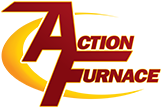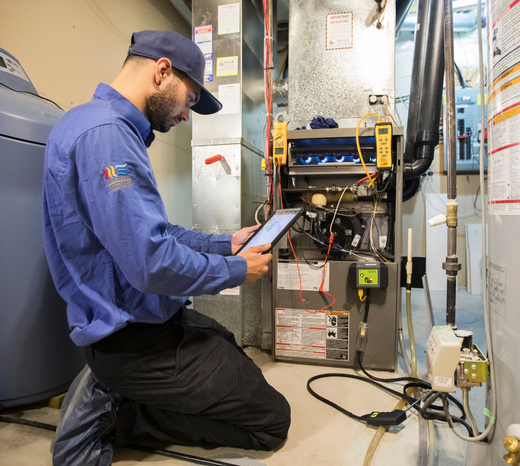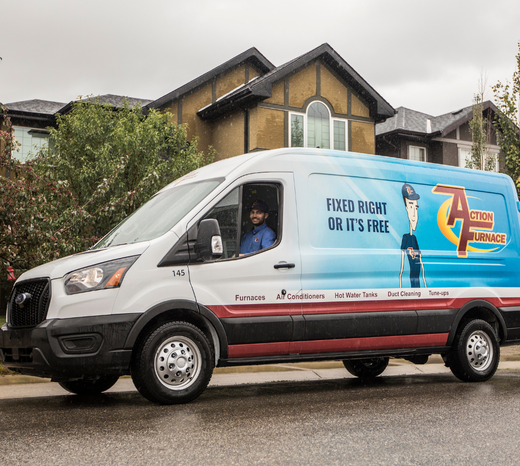Furnace Installations, Furnaces
Winters in Alberta can be among the harshest in any Canadian province, with temperatures known to drop as low as -40 °C. That’s cold enough to gi...
Winters in Alberta can be among the harshest in any Canadian province, with temperatures known to drop as low as -40 °C. That’s cold enough to give you hypothermia in just five to seven minutes, so we’re not exaggerating when we say it’s vital to make sure your heating system functions properly during those icy months!
Hopefully you’re already doing regular maintenance and scheduling annual furnace repairs, but it might also be time to think about buying a new furnace altogether. To help you stay toasty warm all winter, we’ve put together a handy buyer’s guide that can tell you what to consider while you’re shopping and what to expect when having a new furnace installed. Grab a blanket and a cup of cocoa, and read on!
See also: furnace tune-ups

How Does a Forced-Air Furnace Work?
Forced air furnaces heat air and blow it through the ducts in your home. The warm air enters the living space through a series of supply vents, while the stale air is removed by the return vents and pulled back into the system. As a result, you get to enjoy consistent heat and comfort.
It’s a simple concept, but it takes several different mechanisms all working together to make it happen properly. Here’s a more detailed breakdown of what happens when you fire up your forced-air furnace:
- The thermostat detects the current air temperature in your home and turns the furnace on when it goes below a certain level.
- The furnace uses a fuel source to create heat. Common heat sources include electricity, oil, or natural gas.
- Oil or gas furnaces use a heat exchanger to collect exhaust gasses and expel them through vents to the outside as the air in the system warms up.
- Your blower sends the cold air in your home through the return vents. The cold air circulates in the heat exchanger until its temperature rises.
- The air plenum sends the hot air back into your home through the supply vents.
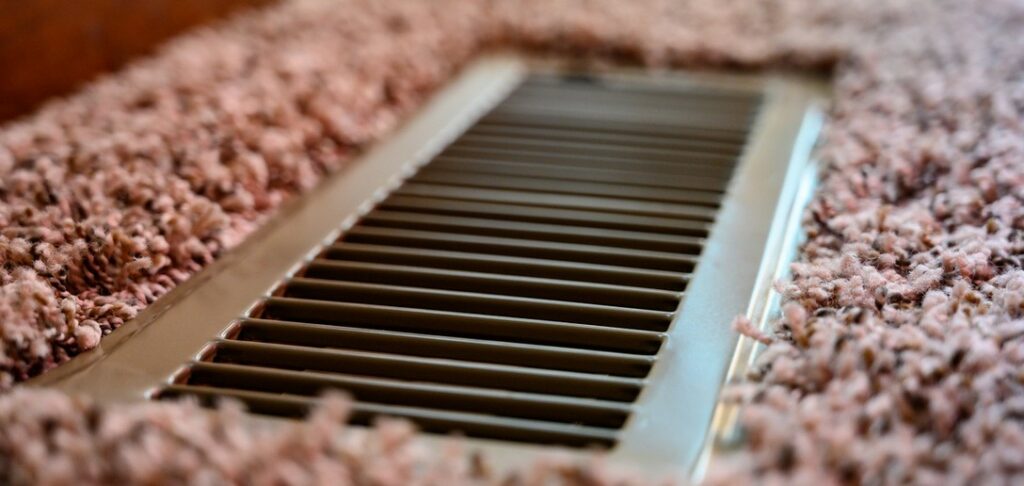
What to Think about When Buying a New Furnace in Alberta
Replacing the furnace in your Alberta home can save you money on monthly heating bills and make your home a more enjoyable environment—but there are a few things you’ll want to consider:
Fuel Types: Electric, Oil, or Natural Gas?
Depending on where you live, some fuel types might make more sense than others. For example:
- If you live in a rural area, an oil furnace might be best. Remote parts of Alberta don’t always have access to natural gas lines, and oil furnaces produce heat fast.
- If you live in a town or city with natural gas lines, a gas furnace is probably your best bet because the fuel source is cost-effective and easily available.
- If you want to spend extra money for a furnace that makes less noise, it’s worth considering an electric forced air furnace. Just remember that while you won’t pay for oil or gas to run it, it will drive up your electricity bill—and these units often cost more off the top as well.
Sizing & Efficiency
How Large Is Your Home?
Any furnace you buy has to produce enough heat to warm your living space efficiently. The rule of thumb is to buy a forced air furnace with 30 to 60 Btus for each square foot of space you need to heat—but in cooler climates like Alberta’s, you can expect this number to be on the higher end of the spectrum.
Remember also that square footage alone isn’t the only factor that determines how powerful your furnace needs to be. There’s also something called form factor, which relates to the volume of space you want heated. Rooms with higher ceilings and alcoves have more space inside than regularly-shaped ones, even if their square footage is identical.
Additional Factors
Any of the following can also affect the level of power your new furnace needs:
- How well your home is insulated
- How many windows, doors, and other openings your home has
- The quality of the seals on these openings
- The materials used to build your home and how well they hold heat
We can tell you more about your home’s heating needs when you contact us about your new furnace installation.
What about Your Ductwork?
The ducts in your home must be appropriate for any new furnace you’re planning to install. That doesn’t always mean new furnaces require new ducts—but since ducts and furnaces have a similar lifespan, it’s often best to replace them around the same time.
You might also need to change your home’s ductwork if you’re planning to divide your home into heating zones. Having dual zones lets you control the temperature in two different parts of your home independently, using a heating damper to divide your ducts and an additional thermostat for the second zone.
You can add more dampers and thermostats to create a multi-zone system in your home as well, as long as you’re prepared for the extra work involved during the installation. Having multiple zones gives you more control over how much of your home is heated at any given time, allowing you to be more efficient about your energy consumption.
AFUE Ratings
Every furnace has an AFUE (annual fuel utilization efficiency) rating. A higher AFUE rating means your furnace will use less fuel throughout the heating season.
Just remember that an AFUE rating is only one part of making sure your furnace is efficient—you also have to be sure it’s properly sized and installed. Also, keep in mind that this rating only applies to the actual fuel source your furnace uses to produce heat, and doesn’t include things like the electricity needed to power controls or displays.
Where Should Your Furnace Go?
The location of your new furnace is also important to consider. You’ll want to make sure it’s in a place where:
- Enough air can reach the heat exchanger
- The fuel source (electricity, gas line, or oil tank) is accessible
- It’s easy to connect with your ductwork or there’s room for new ducts to be installed
- There’s enough room around it for maintenance and it’s not too close to anything that could create a safety or fire hazard
Proper furnace placement can actually be harder than it looks, and the best place for a new furnace might not be where you had the old one. Common areas include basements, utility rooms, garages, large laundry rooms, and even attics in some cases—but every home is different. When you contact Action Furnace, we’ll be able to show you the best place to install your new heating system.
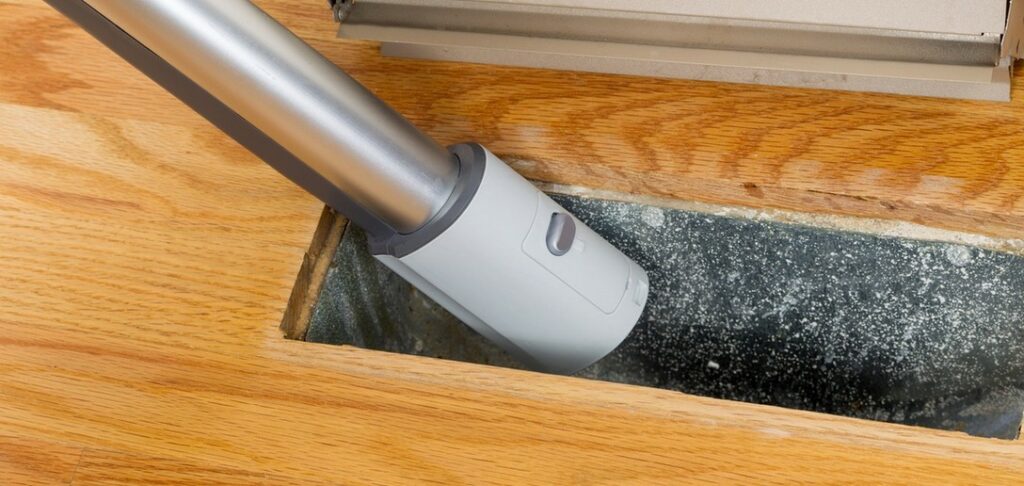
Furnace Maintenance for Alberta Homeowners
Every forced air furnace needs some maintenance and professional service to keep it in good condition. Let’s break down what you can do yourself and what you should call us for:
DIY Furnace Maintenance Tasks
The following tasks are easy enough for most homeowners to handle safely:
- Changing air filters (once a month during cold weather)
- Clearing debris away from air intakes and exterior vents (once before firing up your furnace for the season and once every few weeks afterwards)
- Checking your ducts and joints for leaks (before running your furnace for the first time this year)
Professional Furnace Maintenance & Service
It’s best to have us visit your home and inspect your furnace at least once a year—typically in autumn, before the heating season begins. We’ll use our tools and knowledge to inspect areas you might struggle to reach yourself, and let you know what’s needed to keep your furnace working efficiently. We might:
- Check and vacuum your burners (for oil or gas furnaces)
- Clean or replace your blower’s fan blades
- Check or replace your drive belt
- Ensure all moving parts are properly lubricated
- Seal leaking ducts, joints, or vents
Alberta Furnace FAQ
How Much Are New Furnace Installations?
The average price for a new furnace and installation in Canada is between $3500 and $5500, depending on the heating needs of your home, the quality of the system, and the reliability of your contractors. Avoid “too good to be true” deals, which may be performed by unlicensed contractors using substandard tools or equipment.
How Long Does It Take to Install a Furnace?
Most furnace installations can be performed in under 10 hours, but every home is different—and tasks like breaking up a home into different heating zones can take extra time. When you contact us for furnace replacement, we’ll give you a timeline for the job along with our quote.
What Should My Furnace Sound Like?
Most furnaces hum while running and emit a low blowing noise as air moves throughout the home. These noises should be mild and easy to ignore.
Abnormal noises that may indicate problems with your furnace include:
- Loud buzzing or humming
- Whistling
- Loud banging or clanging sounds
These noises could be signs of simple problems like dirty filters, but in other cases they could indicate serious issues like leaking fuel. If your furnace is making strange sounds, call us for help right away.
What’s the Average Cost to Run a Furnace in the Winter?
Running a furnace usually costs $50-$150 per month during cold weather, but efficiency problems or extreme temperatures can drive up costs. Because newer furnaces are more energy efficient, they can lower your heating costs by up to 45%. This is another good reason to consider replacing your old furnace with a new one.

Should I Leave My Furnace Running or Only Use It When I’m Home?
Leaving your furnace on when you’re away uses more energy than starting it up each time you come home. If you don’t want to be chilly while waiting for your furnace to warm up, try using a programmable thermostat to start the furnace a couple of hours before you return.
What’s the Lifespan of a Furnace?
If you take good care of your furnace, you can expect it to last about 15 to 20 years. Use the tips above to keep your furnace in proper working order and schedule an annual tune-up with our professionals each year to avoid trouble.
If you take good care of your furnace, you can expect it to last about 15 to 20 years. Use the tips above to keep your furnace in proper working order and schedule an annual tune-up with our professionals each year to avoid trouble.
How Do I Know If My Furnace Needs Repairs?
Your furnace might need professional service if:
- It makes strange noises
- The air coming from the supply vents is cold
- No air is coming from the supply vents
- You notice your heating bills getting higher each month
- Your furnace is always turning itself off and on again
- Your home is no longer heating evenly
Action Furnace can show you what’s wrong with your furnace and provide you with options. If you’ve decided it’s time to replace your furnace, we can also explain the process and recommend a system that will work for your home. To find out more about what we can do for you, contact us now and talk to a heating expert in Calgary, Edmonton, or Red Deer.
